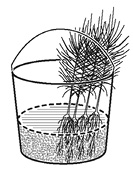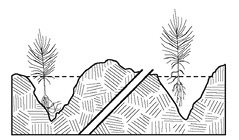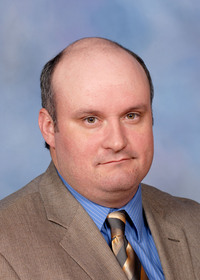4-H Forestry Project No.1 - Tree Planting
Tree planting is one of the most common activities associated with forestry. Anyone can plant trees, but not everyone plants them successfully. Tree planting is easy, but seedlings must be handled and planted correctly if the trees are to live and grow properly.
Tree planting is very important to forestry in Mississippi and the South. Millions of trees are planted in Mississippi annually, and private nurseries in the state produce millions of seedlings each year. However, demand for seedlings is sometimes still more than the supply.
Tree Planting Week is observed every year along with Arbor Day, which is the second Friday in February. Arbor Day is a day set aside for observing the importance of trees by planting memorial trees around schools and homes, along streets and highways, and on farms. You may be able to get some free seedlings during this week.
Check with local officials about a Tree Planting Week celebration. If there is an observance in your county, get involved. If no observance is planned, try to get one started.
It is important to have a purpose in mind before you plant your trees. You may want to plant trees to serve as windbreaks, for erosion control, for timber or wood products production, as shelterbelts, or for wildlife habitat improvement.
These are just some of the many reasons or purposes for planting trees. Your reason for planting will affect the kind of trees you choose to plant, where you place them, and how you go about the task.
Seedlings are taken from nurseries and planted during the winter months while they are dormant. During winter, seedlings are not actively growing and can better withstand the “shock” of being transplanted from the ideal soil at the nursery to a less favorable site that you choose.
Project References
Extension Publication 160 Tree Planting Is Easy
Extension Publication 146 Know Your Trees
Extension Forestry Management Technical Note 4E Seedlings Available from In-state and Regional Nurseries, available from your local MSU Extension office.
Project Materials
At least 50 (preferably 100) tree seedlings (pine or hardwood). Pine seedlings will probably be easier to get.
A planting bar (also called a “dibble” bar) to use in planting your seedlings.
A 2-gallon bucket or canvas bag to hold your seedlings and prevent the roots from drying out.
Sources of Help and Information
You should be able to get plenty of help and good information from several sources in your county. There should be local offices in your county for most of the following agencies or companies:
- County Extension agents
- Area forester, Mississippi Forestry Commission
- District conservationist, Soil Conservation Service, U.S. Department of Agriculture
- Project forester or district ranger, U.S. Forest Service, U.S. Department of Agriculture
- Industry foresters with any one of several forest industry companies
- Self-employed consulting foresters
Instructions
- Contact a local forester for help finding tree seedlings and a planting bar. Seedlings should be available in December through March.
- The Mississippi Forestry Commission no longer maintains public nurseries. To make sure that you will have seedlings during planting season, you may get several other 4-H’ers together and get a local sponsor to help you purchase a bundle of 1,000 seedlings from private nurseries. Contact your local county forester with the Mississippi Forestry Commission or county Extension agent to find out more about this.
- In some counties in Mississippi, the U. S. Forest Service will have free seedlings. If the Forest Service has an office in your area, contact them to find out when they will have seedlings available.
- Locate a suitable planting site. The site may be on your family’s land. If you have trouble locating a planting site, get help from a local forester or Extension agent to help you find a site in need of planting. Be sure you have permission from the landowner if the land does not belong to your family.
- Plant your trees as soon after you receive them as possible.
- If you borrowed a planting bar, clean it and return it to the owner immediately after you finish planting.
- If possible, get a forester to check your tree planting project. Ask the forester to sign your record sheet when your project has been satisfactorily completed.
- Have your adult 4-H leader check your project and sign your record sheet. Cut out and give the record sheet to your 4-H leader. Save all of the introductory material as a future reference as you continue in other 4-H forestry projects.
Planting Techniques
with mattock or grub hoe


A. Insert mattock, lift handle, and pull. B. Place seedling along straight side to correct depth. C. Fill in and pack soil to bottom of roots. D. Finish filling in soil and firm with heel.
with planting bar or dibble


A. Insert dibble at about a 45-degree angle and push straight up. B. Remove dibble and place seedling at correct depth (same as or half-inch deeper than at nursery). C. Insert dibble 2 inches toward planter from seedling and pull handle toward planter, firming soil at bottom of roots. D. Push handle forward from planter, firming soil at top of roots. E. Insert dibble 2 inches from last hole. F. Push forward and then backward to fill hole. G. Fill in last hole by stamping with heel.

Keep roots covered with mud or moss when handling in the field.

The first is planted too deeply with the roots bent; the second is planted too shallowly with some roots exposed.
Open the PDF above for the 4-H Forestry Project No. 1 record form.
Publication 1203 (POD-05-22)
Revised by Brady Self, PhD, Associate Extension Professor, Forestry, from an earlier edition by Thomas A. Monaghan, EdD, retired Extension Professor.
The Mississippi State University Extension Service is working to ensure all web content is accessible to all users. If you need assistance accessing any of our content, please email the webteam or call 662-325-2262.




